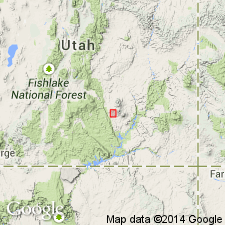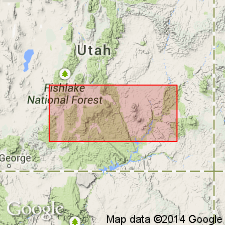
- Usage in publication:
-
- Tarantula Mesa Sandstone
- Modifications:
-
- Named
- Dominant lithology:
-
- Sandstone
- Conglomerate
- AAPG geologic province:
-
- Paradox basin
Summary:
Named for Tarantula Mesa, Garfield Co, UT in Paradox basin. Type section designated in NE1/4 SE1/4 sec 35, T32S, R9E. Was called Masuk Sandstone by Gilbert (1877) and Mesaverde Formation by Hunt (1946). Divided into a lower member which is a grayish-orange, very fine- to fine-grained, subangular to angular, moderately well sorted sandstone with quartz and chert as major constituents, and an upper member which is a conglomerate and sandstone. Conglomerate in upper member has well-rounded, poorly sorted chert granules. The overlying sandstone is grayish-orange, fine- to medium-size, subangular, with moderately sorted quartz grains. Lower member ranges from 44.5 m thick in Spring Canyon to 65.5 m thick at type; upper member ranges from 30 m thick at Spring Canyon to 47 m thick at type. Unconformably overlies Masuk Shale Member of Mancos; unconformably underlies beds on Tarantula Mesa of late Campanian age. Is of Late Cretaceous, or late Campanian age. Correlates with upper sandstone member of Wahweap Formation of Kaiparowits Plateau. Correlates with Castlegate Sandstone and lower part of Price River Formation of Wasatch Plateau. Is a braided stream deposit.
Source: GNU records (USGS DDS-6; Denver GNULEX).

- Usage in publication:
-
- Tarantula Mesa Sandstone
- Modifications:
-
- Contact revised
- AAPG geologic province:
-
- Paradox basin
Summary:
Recognized in Tarantula Mesa, Garfield Co, UT in the Paradox basin. Lower contact revised in that Tarantula Mesa Sandstone overlies Masuk Formation. Masuk is raised in stratigraphic rank from Masuk Member of Mancos Shale to formation rank because of its distinctive lithology and mappability. Considered equivalent to Wahweap Formation. Stratigraphic charts. Considered to be of nonmarine origin and of Campanian age.
Source: GNU records (USGS DDS-6; Denver GNULEX).
For more information, please contact Nancy Stamm, Geologic Names Committee Secretary.
Asterisk (*) indicates published by U.S. Geological Survey authors.
"No current usage" (†) implies that a name has been abandoned or has fallen into disuse. Former usage and, if known, replacement name given in parentheses ( ).
Slash (/) indicates name conflicts with nomenclatural guidelines (CSN, 1933; ACSN, 1961, 1970; NACSN, 1983, 2005, 2021). May be explained within brackets ([ ]).

